
I’m quite positive of only a few things; one of them is that there is now a much great appreciation for golden age animation than there ever has been, and that the information and the films are now much more readily available for those that are interested than ever before. I wish there was an even correlation between interest and studio interest in releasing things, but that will just have to wait, for now anyway. At least it’s leading to many things becoming available in one form or another. The bigger mission is in the hands of those that love these old cartoons, and that’s to share them, enjoy them, let other people know something about them. They’re enjoying a new life each time you do.
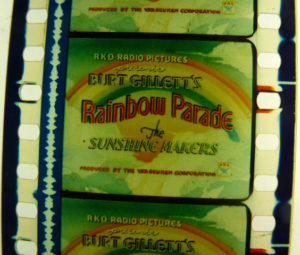 I’m both incredible happy (and, some days, burdened) by all the Thunderbean titles in some sort of process right now, both ‘official’ and ‘special. I’ll be glad when December is all done and a chunk of these projects are out the door. Each of these things takes a bunch of time and energy, but I’m pretty happy with how things are currently moving forward overall. The last few weeks have been a new learning curve in color correction on the Rainbow Parade set (the first half of the series). All the work and racking down material has taken way, way longer on this project than I ever thought it would, but I can honestly say that we’ve gotten the best of the best material that exists (that we know of!) at this point, so I have no real regrets in that way. Same with the Flip the Frog’s.
I’m both incredible happy (and, some days, burdened) by all the Thunderbean titles in some sort of process right now, both ‘official’ and ‘special. I’ll be glad when December is all done and a chunk of these projects are out the door. Each of these things takes a bunch of time and energy, but I’m pretty happy with how things are currently moving forward overall. The last few weeks have been a new learning curve in color correction on the Rainbow Parade set (the first half of the series). All the work and racking down material has taken way, way longer on this project than I ever thought it would, but I can honestly say that we’ve gotten the best of the best material that exists (that we know of!) at this point, so I have no real regrets in that way. Same with the Flip the Frog’s.
These days have been filled with keeping up with orders and trying really hard to get all the special and pre-orders to everyone. We’re still working on that but thankfully almost caught up.
Last week I gave a presentation as part of the Baltimore AMIA conference as a member of The Reel Thing technical symposium. It was the first time I’ve talked in front of an audience to any extent about some of the process and challenges involved in golden age cartoon restoration. I was a little less than fully polished and organized, but I think it still came out overall ok. Talking with some folks working in preservation was the real highlight for me though — and the great hope of future projects working with some of them. Here’s some of the powerpoint slides (click to enlarge) from the presentation to give you an idea of the flavor and contents- I think they give some indication of the process (documented here as well over the course of these Thursdays):
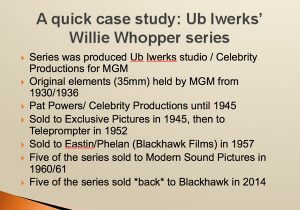
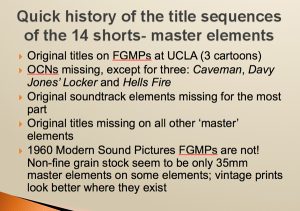
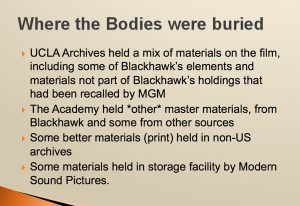
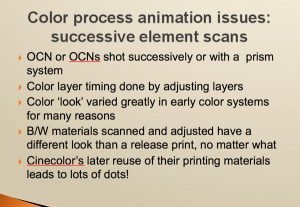
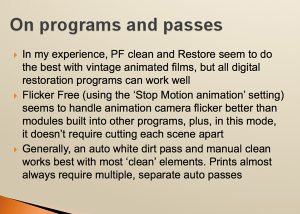
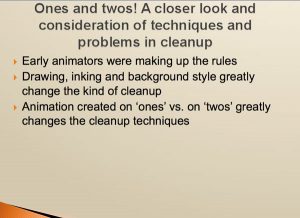

It was really fun being able to talk a little about this stuff to an audience that deals with a lot of these things on a day to day basis.
Here is a comparison I put together of the work in progress on Parrotville Old Folks. I selected some clips from this and showed them during the presentation. While not quite final, it gives a pretty good idea of what steadying, deflickering and dust/dirt cleanup look like. I know I said I wouldn’t talk about Rainbow Parades any more. I’ll try to keep to that until we’re done with this one…
And, here’s an example of the dreaded ‘DVNR’ effects on animation. Here’s a single, not very aggressive auto pass on an admittedly beat up and incomplete 35mm Nitrate print of Felix Dines and Pines. One of the challenges in animation is figuring out just how much to automate and where to only work by hand (on a film this bad you really do need to auto pass and carefully ‘put back’ all the things the auto-pass eliminated. It isn’t that the footage is gone, it just needs to be ‘undone’ just on those specific areas. Note this original print is tinted near the end of the film. Cleaning up Felix the Cat films is really difficult!
Have a good week everyone!


 Steve Stanchfield is an animator, educator and film archivist. He runs Thunderbean Animation, an animation studio in Ann Arbor, Michigan and has compiled over a dozen archival animation DVD collections devoted to such subjects at Private Snafu, The Little King and the infamous Cubby Bear. Steve is also a professor at the College for Creative Studies in Detroit.
Steve Stanchfield is an animator, educator and film archivist. He runs Thunderbean Animation, an animation studio in Ann Arbor, Michigan and has compiled over a dozen archival animation DVD collections devoted to such subjects at Private Snafu, The Little King and the infamous Cubby Bear. Steve is also a professor at the College for Creative Studies in Detroit.






















Parrotville Old Folks, What a wonderful cartoon!
Just had to say, Steve, I was NOT prepared for the STUNNING job you have done on the recent NOVELTOONS blu-ray set. Absolutely gorgeous, rich restorations that bring a fresh breath of life to these wonderful cartoons. Please—KEEP UP THE OUTSTANDING WORK!
How do I get the Betty Boop ‘special’ set. I’ve tried to contact you in different ways since back in October, with no response. The thing you were supposed to click on didn’t work for me. Thank you.
In the video of Felix Dines and Pines in the second 0:34 the bird is noticed a few drops of fright and also at the tip of the tail of the Felix Cat but they are not noticed in the image that says Auto pass cleanup
Also when Felix sticks the fork in the ground some lines are visible that jump from the fork but in the image that says Auto pass cleanup they notice less
In the seconds 0:32
Personally I’ve always found the Parrotville cartoons about as dull as children’s scissors, but they do have their good points. The animation is certainly first-rate; take for example the scene where the Captain plays fiddle while dancing in a circle. When you consider that a person playing the violin is just about the hardest thing in the world to draw (try it yourself if you don’t believe me), and that the character had to be drawn from all angles and animated accordingly without the benefit of a living model, it’s apparent what a tour de force this cartoon really is. Gillett attempted something similar in Disney’s “The Three Little PIgs”, but while the first two (the flutist and his violinist brother) do occasionally dance in circles, they never play their instruments while doing so. No question about it, Burt Gillett was one of the all-time greats, and it’s wonderful to see his work in such a high-quality restored print.
When Grandpa’s sweetheart asks him “How’m I doin’?” and he replies “Hey, hey!”, that was the title of a 1932 Don Redman song; Redman and his orchestra recorded a version of it for the Betty Boop cartoon “I Heard” in 1933. It was also a major hit for the Mills Brothers and became one of their signature tunes. It’s nice to see the Parrotville Old Folks keeping up with current trends in popular music.
“How Am I Doin’?” is indeed by Don Redman. It was first recorded by Clara Smith on 5/25/26. The Fletcher Henderson version of 1932 is also notable. A wonderful example of how a song’s performance style can move with the times!